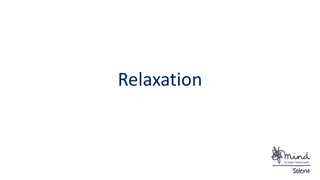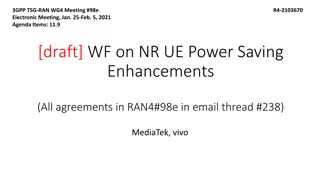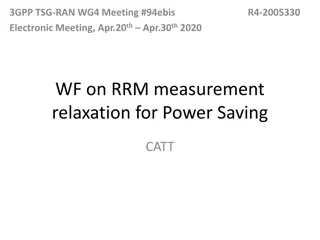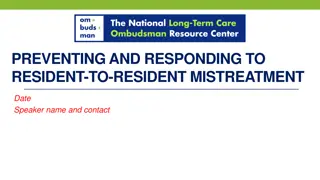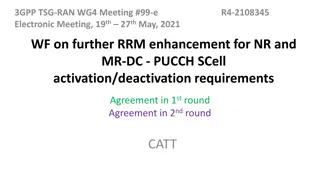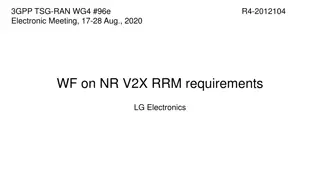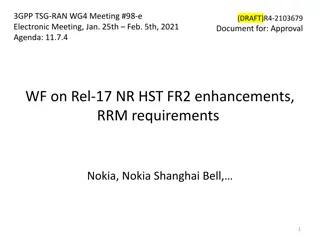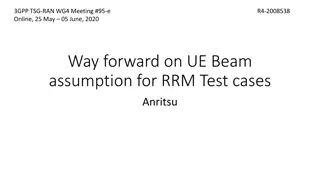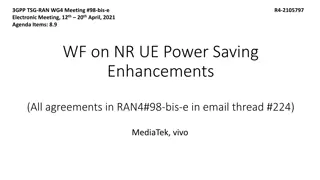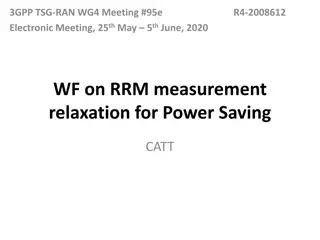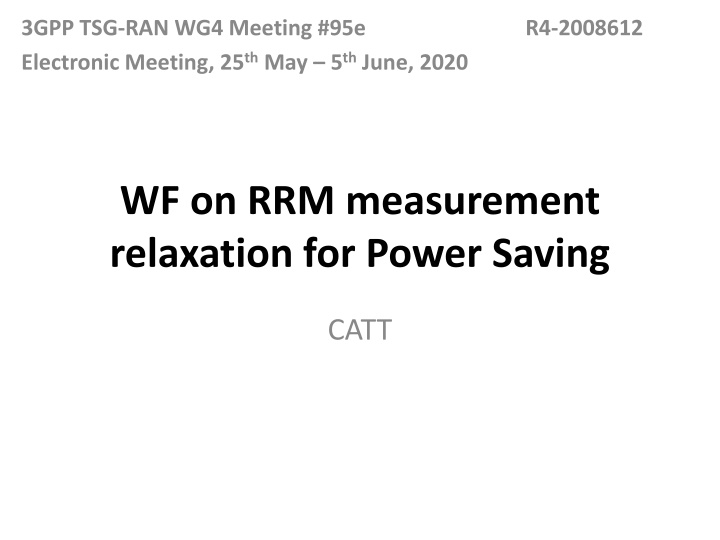
RRM Measurement Relaxation Methodologies for Power Saving in Cellular Networks
Explore the methods and criteria for relaxing RRM measurements in cellular networks to achieve power savings. Learn about different scenarios, transition requirements, and relaxation criteria based on mobility and network configurations. This detailed guide provides insights into optimizing measurement intervals and prioritizing inter-RAT measurements for enhanced efficiency.
Download Presentation

Please find below an Image/Link to download the presentation.
The content on the website is provided AS IS for your information and personal use only. It may not be sold, licensed, or shared on other websites without obtaining consent from the author. If you encounter any issues during the download, it is possible that the publisher has removed the file from their server.
You are allowed to download the files provided on this website for personal or commercial use, subject to the condition that they are used lawfully. All files are the property of their respective owners.
The content on the website is provided AS IS for your information and personal use only. It may not be sold, licensed, or shared on other websites without obtaining consent from the author.
E N D
Presentation Transcript
3GPP TSG-RAN WG4 Meeting #95e Electronic Meeting, 25thMay 5thJune, 2020 R4-2008612 WF on RRM measurement relaxation for Power Saving CATT
WF on RRM measurement relaxation scaling factor of measurement interval Use 3 times fixed scaling factor of measurement interval for scenario #1(Low mobility scenario) and scenario #2 (Not-in-cell-edge scenario) The measurement relaxation method for higher priority or equal/lower priority applies to inter-RAT measurement with higher priority or equal/lower priority. When network configures the parameters of both low mobility and not-at-cell-edge criteria, if network indicates option b, the relaxation method corresponding to scenario #3 can be applied when both relaxation criteria have been fulfilled
WF on minimum requirement at transition period When switching from scenario #1 or #2 to scenario #3, the UE shall fulfil the requirements corresponding to scenario #1 or #2 for N DRX cycles and thereafter switch to requirements corresponding to scenario #3 When switching from scenario #3 to scenario #1 or #2, the UE shall fulfil the requirements corresponding to scenario #1 or #2 upon fulfilling the switching criteria. When switching from normal mode to scenario #1/#2/#3, the UE shall fulfil the requirements corresponding to normal mode for N DRX cycles and thereafter switch to requirements corresponding to scenario #1/#2/#3 When switching from scenario #1/#2/#3 to normal mode, the UE shall fulfil the requirements corresponding to normal mode upon fulfilling the switching criteria. No requirements will be defined for the case of multiple transitions of scenarios within one measurement period.
WF on RRM measurement relaxation When Srxlev > SnonIntraSearchP and Squal > SnonIntraSearchQ, if criteria of low mobility and not in cell edge are both fulfilled, UE can stop both equal/low priority and high priority inter-freq/inter-RAT measurements 1 hour time interval applies to the measurement relaxation since last measurement for cell reselection for higher priority carriers When Srxlev > SnonIntraSearchP and Squal > SnonIntraSearchQ and only criteria of low mobility is configured, if the low mobility criteria is fulfilled UE is not required to do any lower and equal priority inter-frequency/inter- RAT measurement When NW indicates that higher priority carrier measurements can be relaxed (highPriorityMeasRelax), UE measures higher priority inter- frequency/inter-RAT layers at least every 1 hour When NW does not indicate that higher priority carrier measurements can be relaxed, UE measures higher priority inter-frequency/inter-RAT layers at least every Thigher_priority_search (60 sec).
WF on RRM measurement relaxation The evaluation rate for measurement relaxation mode triggering shall be the same as current serving cell evaluation rate defined in 38.133 RAN4 not specify intra/inter-frequency requirement when the threshold configured for not-at-cell-edge condition is higher than that for cell center condition of SnonIntraSearchP or SnonIntraSearchQ . This rule also applies in SIntraSearchP or SIntraSearchQ . Measurements on EMR carriers should not be relaxed if T331 is running It is up to RAN2 s decision on whether to introduce carrier specific threshold for inter-frequency measurement relaxation.



